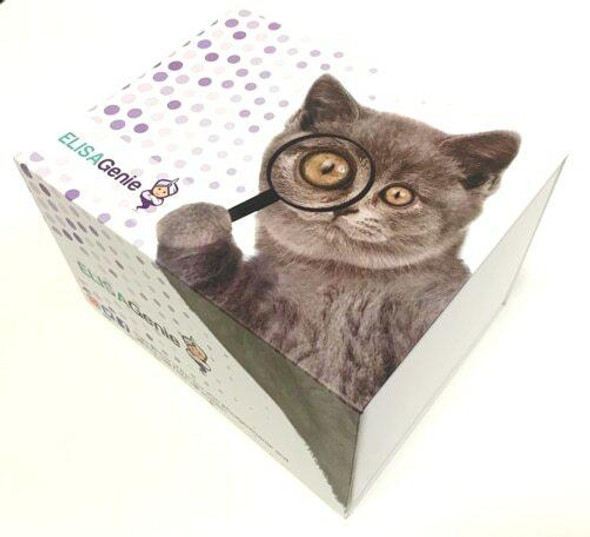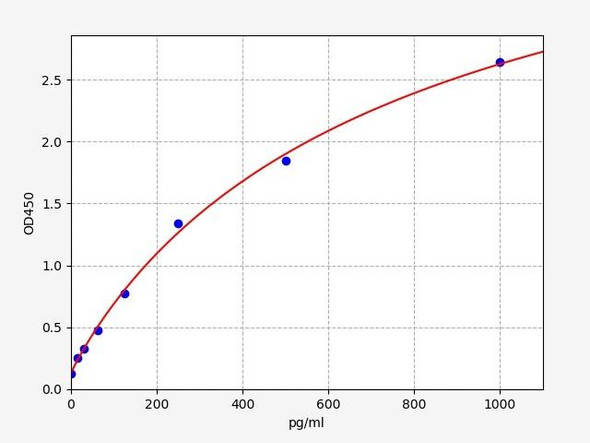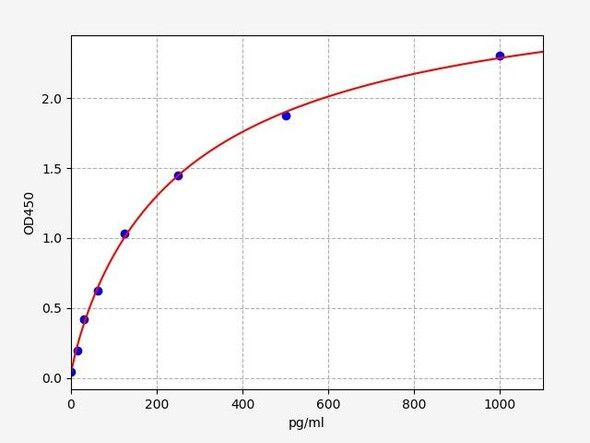Human CGRP / Calcitonin gene-related peptide 1 ELISA Kit
- SKU:
- HUFI01117
- Product Type:
- ELISA Kit
- Size:
- 96 Assays
- Uniprot:
- P06881
- Sensitivity:
- 18.75pg/ml
- Range:
- 31.25-2000pg/ml
- ELISA Type:
- Sandwich
- Synonyms:
- CALCA, Calcitonin gene-related peptide 1, Alpha-type CGRP, Calcitonin gene-related peptide I, CGRP-I
- Reactivity:
- Human
Description
Human CGRP / Calcitonin gene-related peptide 1 ELISA Kit
GPCR signaling and peptide ligand-binding receptors are among the pathways it is related to CGRP. CGRP promotes vasodilation by contracting blood vessels, including the coronary, cerebral and systemic circulation. Its presence in the CNS suggests a neurotransmitter or neuromodulator function. CGRP also elevates platelet cAMP. Calcitonin encourages the incorporation of calcium and phosphate into the bones. Katacalcin is a powerful plasma calcium-lowering peptide that lowers blood calcium and phosphate levels.
Human CGRP / Calcitonin gene-related peptide 1 ELISA Kit - Information
The Assay Genie CGRP / Calcitonin gene-related peptide 1 ELISA Kit can assay for CGRP / Calcitonin gene-related peptide 1 in the following samples: serum, blood, plasma, cell culture supernatant and other related supernatants and tissues.
How our CGRP / Calcitonin gene-related peptide 1 ELISA Kits Work?The Assay Genie (enzyme-linked immunosorbent assays) assay kits are designed for the quantitative measurement of analytes in a wide variety of samples. As today's scientists demand high quality consistent data for high impact journals, Assay Genie have developed our range of sensitive, fast and reliable ELISA kit assays to meet and exceed those demands. Our assay kits use a quantitative sandwich ELISA technique and each kit comes with highly specific antibodies pre-coated onto a 96-well microtiter plate.
At Assay Genie we understand the need for speed! Therefore, we have developed an ultra-fast protocol meaning you achieve your results rapidly. So, once you have prepared and plated your samples, blanks and standards, you simply incubate with a highly specific biotin-conjugated primary antibody and Avidin conjugated to Horseradish Peroxidase (HRP) and incubate for the appropriate length of time. After washing the plate according to the protocol and addition of the TMB (3,3',5,5'-Tetramethylbenzidine) solution, the appearance of a blue colour should be detected due to an enzymatic reaction catalysed by HRP. Next step is the addition of the Stop Solution which terminates the HRP reaction and the blue colour turns yellow with the signal intensity measured on a plate reader at 450nm. The amount of bound CGRP / Calcitonin gene-related peptide 1 is proportional to the signal generated by the reaction meaning the kit assay gives you a quantitative measurement of the analyte in your samples.
Human CGRP / Calcitonin gene-related peptide 1 ELISA Kit - Data
| Description | CGRP induces vasodilation. It dilates a variety of vessels including the coronary, cerebral and systemic vasculature. Its abundance in the CNS also points toward a neurotransmitter or neuromodulator role. It also elevates platelet cAMP. | |
| Post-Translational Modification | ||
| Uniprot ID | P06881 |
| Alias | CALCA/Calcitonin gene-related peptide 1/Alpha-type CGRP/Calcitonin gene-related peptide I/CGRP-I | ||||||||||||||||||||
| Detection method | Sandwich ELISA Double Antibody | ||||||||||||||||||||
| Application | This immunoassay kit allows for the in vitro quantitative determination of CALCA concentrations in serum plasma and other biological fluids. | ||||||||||||||||||||
| Size | 96T | ||||||||||||||||||||
| Range | 31.2-2000pg/ml | ||||||||||||||||||||
| Sensitivity | < 18.75pg/ml | ||||||||||||||||||||
| Storage | 4'C for 6 months | ||||||||||||||||||||
| Recovery | Matrices listed below were spiked with certain level of CALCA and the recovery rates were calculated by comparing the measured value to the expected amount of CALCA in samples.
| ||||||||||||||||||||
| Linearity | The linearity of the kit was assayed by testing samples spiked with appropriate concentration of CALCA and their serial dilutions. The results were demonstrated by the percentage of calculated concentration to the expected.
| ||||||||||||||||||||
| CV(%) | Intra-Assay: CV<8% | ||||||||||||||||||||
| Note | For Research Use Only |
Human CGRP / Calcitonin gene-related peptide 1 ELISA Kit Protocol
The below protocol is a sample protocol for Human CGRP / Calcitonin gene-related peptide 1 ELISA Kit using a biotinylated detection antibody and streptavidin-HRP. Sandwich ELISAs allow for the detection and quantification of an analyte in a sample by using known analyte concentrations as standards and plotting absorbance of known concentrations vs known standard concentrations. This allows the researcher to calculate the amount of Human CGRP / Calcitonin gene-related peptide 1 present in their sample.
Before adding to wells, equilibrate the SABC working solution and TMB substrate for at least 30 min at 37 °C. When diluting samples and reagents, they must be mixed completely and evenly. It is recommended to plot a standard curve for each test.
Kit Protocol:
| 1. | Set standard, test sample and control (zero) wells on the pre-coated plate respectively, and then, record their positions. It is recommended to measure each standard and sample in duplicate. Wash plate 2 times before adding standard, sample and control (zero) wells! |
| 2. | Aliquot 0.1ml standard solutions into the standard wells. |
| 3. | Add 0.1 ml of Sample / Standard dilution buffer into the control (zero) well. |
| 4. | Add 0.1 ml of properly diluted sample ( Human serum, plasma, tissue homogenates and other biological fluids.) into test sample wells. |
| 5. | Seal the plate with a cover and incubate at 37 °C for 90 min. |
| 6. | Remove the cover and discard the plate content, clap the plate on the absorbent filter papers or other absorbent material. Do NOT let the wells completely dry at any time. Wash plate X2. |
| 7. | Add 0.1 ml of Biotin- detection antibody working solution into the above wells (standard, test sample & zero wells). Add the solution at the bottom of each well without touching the side wall. |
| 8. | Seal the plate with a cover and incubate at 37°C for 60 min. |
| 9. | Remove the cover, and wash plate 3 times with Wash buffer. Let wash buffer rest in wells for 1 min between each wash. |
| 10. | Add 0.1 ml of SABC working solution into each well, cover the plate and incubate at 37°C for 30 min. |
| 11. | Remove the cover and wash plate 5 times with Wash buffer, and each time let the wash buffer stay in the wells for 1-2 min. |
| 12. | Add 90 µl of TMB substrate into each well, cover the plate and incubate at 37°C in dark within 10-20 min. (Note: This incubation time is for reference use only, the optimal time should be determined by end user.) And the shades of blue can be seen in the first 3-4 wells (with most concentrated standard solutions), the other wells show no obvious color. |
| 13. | Add 50 µl of Stop solution into each well and mix thoroughly. The color changes into yellow immediately. |
| 14. | Read the O.D. absorbance at 450 nm in a microplate reader immediately after adding the stop solution. |
Human CGRP / Calcitonin gene-related peptide 1 ELISA Kit components | 96 Assays | Storage |
| ELISA Microplate(Dismountable) | 8×12 strips | 4°C for 6 months |
| Lyophilized Standard | 2 | 4°C/-20°C |
| Sample/Standard Dilution Buffer | 20ml | 4°C |
| Biotin-labeled Antibody(Concentrated) | 120ul | 4°C (Protect from light) |
| Antibody Dilution Buffer | 10ml | 4°C |
| HRP-Streptavidin Conjugate(SABC) | 120ul | 4°C (Protect from light) |
| SABC Dilution Buffer | 10ml | 4°C |
| TMB Substrate | 10ml | 4°C (Protect from light) |
| Stop Solution | 10ml | 4°C |
| Wash Buffer(25X) | 30ml | 4°C |
| Plate Sealer | 5 | - |
Other materials and equipment required:
The Assay Genie Human CGRP / Calcitonin gene-related peptide 1 ELISA Kit will require other equipment and materials to carry out the assay. Please see list below for further details.- Microplate reader with 450 nm wavelength filter
- Multichannel Pipette, Pipette, microcentrifuge tubes and disposable pipette tips
- Incubator
- Deionized or distilled water
- Absorbent paper
- Buffer resevoir
Sample Preparation
When carrying out an ELISA assay it is important to prepare your samples in order to achieve the best possible results. Below we have a list of procedures for the preparation of samples for different sample types.
| Sample Type | Protocol |
Serum | If using serum separator tubes, allow samples to clot for 30 minutes at room temperature. Centrifuge for 10 minutes at 1,000x g. Collect the serum fraction and assay promptly or aliquot and store the samples at -80°C. Avoid multiple freeze-thaw cycles. If serum separator tubes are not being used, allow samples to clot overnight at 2-8°C. Centrifuge for 10 minutes at 1,000x g. Remove serum and assay promptly or aliquot and store the samples at -80°C. Avoid multiple freeze-thaw cycles. |
Plasma | Collect plasma using EDTA or heparin as an anticoagulant. Centrifuge samples at 4°C for 15 mins at 1000 × g within 30 mins of collection. Collect the plasma fraction and assay promptly or aliquot and store the samples at -80°C. Avoid multiple freeze-thaw cycles. Note: Over haemolysed samples are not suitable for use with this kit. |
Urine & Cerebrospinal Fluid | Collect the urine (mid-stream) in a sterile container, centrifuge for 20 mins at 2000-3000 rpm. Remove supernatant and assay immediately. If any precipitation is detected, repeat the centrifugation step. A similar protocol can be used for cerebrospinal fluid. |
Cell culture supernatant | Collect the cell culture media by pipette, followed by centrifugation at 4°C for 20 mins at 1500 rpm. Collect the clear supernatant and assay immediately. |
Cell lysates | Solubilize cells in lysis buffer and allow to sit on ice for 30 minutes. Centrifuge tubes at 14,000 x g for 5 minutes to remove insoluble material. Aliquot the supernatant into a new tube and discard the remaining whole cell extract. Quantify total protein concentration using a total protein assay. Assay immediately or aliquot and store at ≤ -20 °C. |
Tissue homogenates | The preparation of tissue homogenates will vary depending upon tissue type. Rinse tissue with 1X PBS to remove excess blood & homogenize in 20ml of 1X PBS (including protease inhibitors) and store overnight at ≤ -20°C. Two freeze-thaw cycles are required to break the cell membranes. To further disrupt the cell membranes you can sonicate the samples. Centrifuge homogenates for 5 mins at 5000xg. Remove the supernatant and assay immediately or aliquot and store at -20°C or -80°C. |
Tissue lysates | Rinse tissue with PBS, cut into 1-2 mm pieces, and homogenize with a tissue homogenizer in PBS. Add an equal volume of RIPA buffer containing protease inhibitors and lyse tissues at room temperature for 30 minutes with gentle agitation. Centrifuge to remove debris. Quantify total protein concentration using a total protein assay. Assay immediately or aliquot and store at ≤ -20 °C. |
Breast Milk | Collect milk samples and centrifuge at 10,000 x g for 60 min at 4°C. Aliquot the supernatant and assay. For long term use, store samples at -80°C. Minimize freeze/thaw cycles. |
Human CGRP / Calcitonin gene-related peptide 1 ELISA Kit Protein Information
| UniProt Protein Function: | CALCA iso3: Calcitonin causes a rapid but short-lived drop in the level of calcium and phosphate in blood by promoting the incorporation of those ions in the bones. Belongs to the calcitonin family. 3 isoforms of the human protein are produced by alternative splicing. |
| UniProt Protein Details: | Protein type:Secreted, signal peptide; Secreted Chromosomal Location of Human Ortholog: 11p15.2 Cellular Component: extracellular region; extracellular space Molecular Function:calcitonin receptor binding; identical protein binding; protein binding Biological Process: activation of protein kinase activity; cellular protein metabolic process; elevation of cytosolic calcium ion concentration; elevation of cytosolic calcium ion concentration during G-protein signaling, coupled to IP3 second messenger (phospholipase C activating); embryo implantation; monocyte chemotaxis; negative regulation of bone resorption; negative regulation of transcription, DNA-dependent; positive regulation of adenylate cyclase activity |
| NCBI Summary: | This gene encodes the peptide hormones calcitonin, calcitonin gene-related peptide and katacalcin by tissue-specific alternative RNA splicing of the gene transcripts and cleavage of inactive precursor proteins. Calcitonin is involved in calcium regulation and acts to regulate phosphorus metabolism. Calcitonin gene-related peptide functions as a vasodilator and as an antimicrobial peptide while katacalcin is a calcium-lowering peptide. Multiple transcript variants encoding different isoforms have been found for this gene.[provided by RefSeq, Aug 2014] |
| UniProt Code: | P06881 |
| NCBI GenInfo Identifier: | 76880478 |
| NCBI Gene ID: | 796 |
| NCBI Accession: | NP_001029125.1 |
| UniProt Secondary Accession: | P06881,Q93048, Q9UCP0, |
| UniProt Related Accession: | P01258,P06881 |
| Molecular Weight: | 15,466 Da |
| NCBI Full Name: | calcitonin gene-related peptide 1 isoform alpha-CGRP preproprotein |
| NCBI Synonym Full Names: | calcitonin related polypeptide alpha |
| NCBI Official Symbol: | CALCA |
| NCBI Official Synonym Symbols: | CT; KC; PCT; CGRP; CALC1; CGRP1; CGRP-I |
| NCBI Protein Information: | calcitonin; calcitonin gene-related peptide 1 |
| UniProt Protein Name: | Calcitonin gene-related peptide 1 |
| UniProt Synonym Protein Names: | Alpha-type CGRP; Calcitonin gene-related peptide I; CGRP-I |
| Protein Family: | Calcitonin |
| UniProt Gene Name: | CALCA |
| UniProt Entry Name: | CALCA_HUMAN |
Fill out our quote form below and a dedicated member of staff will get back to you within one working day!






